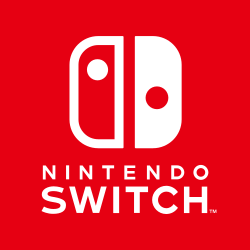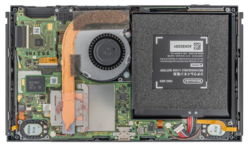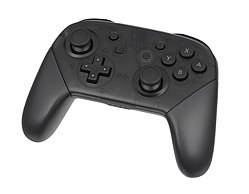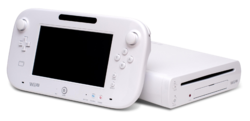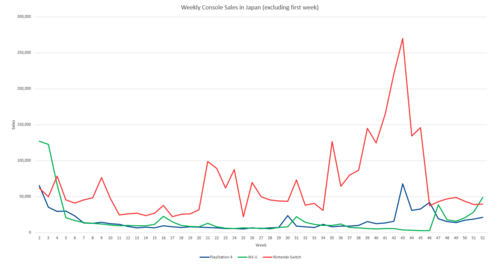- ↑ Numbers are total of Nintendo Switch, Nintendo Switch Lite, and Nintendo Switch OLED units. See footnotes for quarters from September 2019 onward for partition of sales between the Switch and Switch Lite and footnotes for quarters from December 2021 onward for partition of sales between all units.
- 1 2 3 4 5 6 7 8 9 10 11 12 13 14 15 16 17 18 19 20 European sales were counted under "Other" until the quarter ending June 30, 2019.
- ↑ Given as the ratio of total software sales to total hardware sales
- ↑ Nintendo Switch: 9.61 million, Nintendo Switch Lite: 0.39 million
- ↑ Nintendo Switch: 15.84 million, Nintendo Switch Lite: 0.80 million
- ↑ Nintendo Switch: 10.33 million, Nintendo Switch Lite: 0.54 million
- ↑ Nintendo Switch: 3.94 million, Nintendo Switch Lite: 0.22 million
- ↑ Nintendo Switch: 39.72 million, Nintendo Switch Lite: 1.95 million
- ↑ Nintendo Switch: 11.06 million, Nintendo Switch Lite: 1.36 million
- ↑ Nintendo Switch: 18.78 million, Nintendo Switch Lite: 2.09 million
- ↑ Nintendo Switch: 12.60 million, Nintendo Switch Lite: 1.28 million
- ↑ Nintendo Switch: 4.86 million, Nintendo Switch Lite: 0.46 million
- ↑ Nintendo Switch: 47.30 million, Nintendo Switch Lite: 5.19 million
- ↑ Nintendo Switch: 11.44 million, Nintendo Switch Lite: 2.00 million
- ↑ Nintendo Switch: 19.79 million, Nintendo Switch Lite: 2.33 million
- ↑ Nintendo Switch: 13.09 million, Nintendo Switch Lite: 1.34 million
- ↑ Nintendo Switch: 5.25 million, Nintendo Switch Lite: 0.53 million
- ↑ Nintendo Switch: 49.57 million, Nintendo Switch Lite: 6.19 million
- ↑ Nintendo Switch: 12.23 million, Nintendo Switch Lite: 2.36 million
- ↑ Nintendo Switch: 20.50 million, Nintendo Switch Lite: 3.61 million
- ↑ Nintendo Switch: 13.91 million, Nintendo Switch Lite: 2.13 million
- ↑ Nintendo Switch: 5.98 million, Nintendo Switch Lite: 0.72 million
- ↑ Nintendo Switch: 52.63 million, Nintendo Switch Lite: 8.82 million
- ↑ Nintendo Switch: 13.37 million, Nintendo Switch Lite: 2.80 million
- ↑ Nintendo Switch: 22.38 million, Nintendo Switch Lite: 4.20 million
- ↑ Nintendo Switch: 15.25 million, Nintendo Switch Lite: 2.48 million
- ↑ Nintendo Switch: 6.93 million, Nintendo Switch Lite: 0.88 million
- ↑ Nintendo Switch: 57.93 million, Nintendo Switch Lite: 10.36 million
- ↑ Nintendo Switch: 15.46 million, Nintendo Switch Lite: 3.42 million
- ↑ Nintendo Switch: 25.40 million, Nintendo Switch Lite: 5.78 million
- ↑ Nintendo Switch: 17.35 million, Nintendo Switch Lite: 3.36 million
- ↑ Nintendo Switch: 8.14 million, Nintendo Switch Lite: 0.97 million
- ↑ Nintendo Switch: 66.34 million, Nintendo Switch Lite: 13.53 million
- ↑ Nintendo Switch: 16.22 million, Nintendo Switch Lite: 3.81 million
- ↑ Nintendo Switch: 26.86 million, Nintendo Switch Lite: 6.41 million
- ↑ Nintendo Switch: 18.11 million, Nintendo Switch Lite: 3.47 million
- ↑ Nintendo Switch: 8.70 million, Nintendo Switch Lite: 1.01 million
- ↑ Nintendo Switch: 69.89 million, Nintendo Switch Lite: 14.70 million
- ↑ Nintendo Switch: 17.05 million, Nintendo Switch Lite: 4.15 million
- ↑ Nintendo Switch: 27.96 million, Nintendo Switch Lite: 6.90 million
- ↑ Nintendo Switch: 18.93 million, Nintendo Switch Lite: 3.73 million
- ↑ Nintendo Switch: 9.26 million, Nintendo Switch Lite: 1.06 million
- ↑ Nintendo Switch: 73.20 million, Nintendo Switch Lite: 15.84 million
- ↑ Nintendo Switch: 17.80 million, Nintendo Switch Lite: 4.26 million
- ↑ Nintendo Switch: 29.01 million, Nintendo Switch Lite: 7.30 million
- ↑ Nintendo Switch: 19.74 million, Nintendo Switch Lite: 3.86 million
- ↑ Nintendo Switch: 9.79 million, Nintendo Switch Lite: 1.10 million
- ↑ Nintendo Switch: 76.34 million, Nintendo Switch Lite: 16.53 million
- ↑ Nintendo Switch: 18.57 million, Nintendo Switch Lite: 4.72 million, Nintendo Switch OLED: 1.07 million
- ↑ Nintendo Switch: 30.96 million, Nintendo Switch Lite: 7.74 million, Nintendo Switch OLED: 1.41 million
- ↑ Nintendo Switch: 21.86 million, Nintendo Switch Lite: 4.21 million, Nintendo Switch OLED: 0.91 million
- ↑ Nintendo Switch: 10.28 million, Nintendo Switch Lite: 1.19 million, Nintendo Switch OLED: 0.61 million
- ↑ Nintendo Switch: 81.68 million, Nintendo Switch Lite: 17.87 million, Nintendo Switch OLED: 3.99 million
- ↑ Nintendo Switch: 18.78 million, Nintendo Switch Lite: 4.84 million, Nintendo Switch OLED: 1.61 million
- ↑ Nintendo Switch: 32.08 million, Nintendo Switch Lite: 8.01 million, Nintendo Switch OLED: 1.94 million
- ↑ Nintendo Switch: 22.15 million, Nintendo Switch Lite: 4.33 million, Nintendo Switch OLED: 1.12 million
- ↑ Nintendo Switch: 10.44 million, Nintendo Switch Lite: 1.23 million, Nintendo Switch OLED: 1.13 million
- ↑ Nintendo Switch: 83.45 million, Nintendo Switch Lite: 18.40 million, Nintendo Switch OLED: 5.80 million
- ↑ Nintendo Switch: 19.01 million, Nintendo Switch Lite: 4.94 million, Nintendo Switch OLED: 2.00 million
- ↑ Nintendo Switch: 32.57 million, Nintendo Switch Lite: 8.34 million, Nintendo Switch OLED: 2.40 million
- ↑ Nintendo Switch: 22.68 million, Nintendo Switch Lite: 4.45 million, Nintendo Switch OLED: 1.58 million
- ↑ Nintendo Switch: 10.52 million, Nintendo Switch Lite: 1.27 million, Nintendo Switch OLED: 1.34 million
- ↑ Nintendo Switch: 84.77 million, Nintendo Switch Lite: 18.99 million, Nintendo Switch OLED: 7.32 million
- ↑ Nintendo Switch: 19.22 million, Nintendo Switch Lite: 4.99 million, Nintendo Switch OLED: 2.74 million
- ↑ Nintendo Switch: 32.99 million, Nintendo Switch Lite: 8.53 million, Nintendo Switch OLED: 3.07 million
- ↑ Nintendo Switch: 22.87 million, Nintendo Switch Lite: 4.51 million, Nintendo Switch OLED: 1.91 million
- ↑ Nintendo Switch: 10.59 million, Nintendo Switch Lite: 1.29 million, Nintendo Switch OLED: 1.62 million
- ↑ Nintendo Switch: 85.67 million, Nintendo Switch Lite: 19.32 million, Nintendo Switch OLED: 9.34 million
- ↑ Nintendo Switch: 19.67 million, Nintendo Switch Lite: 5.29 million, Nintendo Switch OLED: 4.09 million
- ↑ Nintendo Switch: 34.29 million, Nintendo Switch Lite: 9.10 million, Nintendo Switch OLED: 4.26 million
- ↑ Nintendo Switch: 23.96 million, Nintendo Switch Lite: 4.67 million, Nintendo Switch OLED: 3.08 million
- ↑ Nintendo Switch: 10.75 million, Nintendo Switch Lite: 1.33 million, Nintendo Switch OLED: 2.06 million
- ↑ Nintendo Switch: 88.67 million, Nintendo Switch Lite: 20.40 million, Nintendo Switch OLED: 13.49 million
- ↑ Nintendo Switch: 19.73 million, Nintendo Switch Lite: 5.41 million, Nintendo Switch OLED: 4.45 million
- ↑ Nintendo Switch: 34.75 million, Nintendo Switch Lite: 9.42 million, Nintendo Switch OLED: 4.82 million
- ↑ Nintendo Switch: 24.26 million, Nintendo Switch Lite: 4.82 million, Nintendo Switch OLED: 3.50 million
- ↑ Nintendo Switch: 10.84 million, Nintendo Switch Lite: 1.36 million, Nintendo Switch OLED: 2.25 million
- ↑ Nintendo Switch: 89.58 million, Nintendo Switch Lite: 21.02 million, Nintendo Switch OLED: 15.02 million
- ↑ Nintendo Switch: 19.89 million, Nintendo Switch Lite: 5.57 million, Nintendo Switch OLED: 5.33 million
- ↑ Nintendo Switch: 34.91 million, Nintendo Switch Lite: 9.58 million, Nintendo Switch OLED: 5.70 million
- ↑ Nintendo Switch: 24.47 million, Nintendo Switch Lite: 4.89 million, Nintendo Switch OLED: 4.16 million
- ↑ Nintendo Switch: 10.96 million, Nintendo Switch Lite: 1.40 million, Nintendo Switch OLED: 2.66 million
- ↑ Nintendo Switch: 90.23 million, Nintendo Switch Lite: 21.45 million, Nintendo Switch OLED: 17.85 million
- ↑ Nintendo Switch: 20.03 million, Nintendo Switch Lite: 5.71 million, Nintendo Switch OLED: 6.04 million
- ↑ Nintendo Switch: 35.12 million, Nintendo Switch Lite: 9.80 million, Nintendo Switch OLED: 6.11 million
- ↑ Nintendo Switch: 24.67 million, Nintendo Switch Lite: 4.96 million, Nintendo Switch OLED: 4.52 million
- ↑ Nintendo Switch: 11.02 million, Nintendo Switch Lite: 1.45 million, Nintendo Switch OLED: 3.04 million
- ↑ Nintendo Switch: 90.83 million, Nintendo Switch Lite: 21.92 million, Nintendo Switch OLED: 19.71 million
- ↑ Nintendo Switch: 20.26 million, Nintendo Switch Lite: 6.05 million, Nintendo Switch OLED: 7.03 million
- ↑ Nintendo Switch: 36.22 million, Nintendo Switch Lite: 10.46 million, Nintendo Switch OLED: 7.17 million
- ↑ Nintendo Switch: 25.43 million, Nintendo Switch Lite: 5.21 million, Nintendo Switch OLED: 5.51 million
- ↑ Nintendo Switch: 11.08 million, Nintendo Switch Lite: 1.48 million, Nintendo Switch OLED: 3.47 million
- ↑ Nintendo Switch: 92.98 million, Nintendo Switch Lite: 23.20 million, Nintendo Switch OLED: 23.18 million
- ↑ Nintendo Switch: 20.34 million, Nintendo Switch Lite: 6.17 million, Nintendo Switch OLED: 7.50 million
- ↑ Nintendo Switch: 36.45 million, Nintendo Switch Lite: 10.61 million, Nintendo Switch OLED: 7.47 million
- ↑ Nintendo Switch: 25.55 million, Nintendo Switch Lite: 5.25 million, Nintendo Switch OLED: 5.69 million
- ↑ Nintendo Switch: 11.11 million, Nintendo Switch Lite: 1.51 million, Nintendo Switch OLED: 3.68 million
- ↑ Nintendo Switch: 93.45 million, Nintendo Switch Lite: 23.54 million, Nintendo Switch OLED: 24.34 million
- ↑ Nintendo Switch: 20.45 million, Nintendo Switch Lite: 6.30 million, Nintendo Switch OLED: 8.05 million
- ↑ Nintendo Switch: 36.69 million, Nintendo Switch Lite: 10.73 million, Nintendo Switch OLED: 7.75 million
- ↑ Nintendo Switch: 25.69 million, Nintendo Switch Lite: 5.32 million, Nintendo Switch OLED: 5.89 million
- ↑ Nintendo Switch: 11.13 million, Nintendo Switch Lite: 1.53 million, Nintendo Switch OLED: 3.90 million
- ↑ Nintendo Switch: 93.97 million, Nintendo Switch Lite: 23.87 million, Nintendo Switch OLED: 25.58 million
- ↑ Nintendo Switch: 20.60 million, Nintendo Switch Lite: 6.51 million, Nintendo Switch OLED: 8.52 million
- ↑ Nintendo Switch: 36.99 million, Nintendo Switch Lite: 10.94 million, Nintendo Switch OLED: 8.18 million
- ↑ Nintendo Switch: 25.96 million, Nintendo Switch Lite: 5.49 million, Nintendo Switch OLED: 6.07 million
- ↑ Nintendo Switch: 11.16 million, Nintendo Switch Lite: 1.57 million, Nintendo Switch OLED: 4.07 million
- ↑ Nintendo Switch: 94.70 million, Nintendo Switch Lite: 24.51 million, Nintendo Switch OLED: 26.83 million
- ↑ Nintendo Switch: 20.83 million, Nintendo Switch Lite: 6.79 million, Nintendo Switch OLED: 9.20 million
- ↑ Nintendo Switch: 37.70 million, Nintendo Switch Lite: 11.29 million, Nintendo Switch OLED: 8.83 million
- ↑ Nintendo Switch: 26.47 million, Nintendo Switch Lite: 5.60 million, Nintendo Switch OLED: 6.92 million
- ↑ Nintendo Switch: 11.18 million, Nintendo Switch Lite: 1.59 million, Nintendo Switch OLED: 4.45 million
- ↑ Nintendo Switch: 96.18 million, Nintendo Switch Lite: 25.27 million, Nintendo Switch OLED: 29.40 million
- ↑ Nintendo Switch: 20.89 million, Nintendo Switch Lite: 6.86 Million, Nintendo Switch OLED: 9.45 Million
- ↑ Nintendo Switch: 37.83 million, Nintendo Switch Lite: 11.39 Million, Nintendo Switch OLED: 9.09 Million
- ↑ Nintendo Switch: 26.53 million, Nintendo Switch Lite: 5.63 Million, Nintendo Switch OLED: 7.03 Million
- ↑ Nintendo Switch: 11.19 million, Nintendo Switch Lite: 1.60 Million, Nintendo Switch OLED: 4.62 Million
- ↑ Nintendo Switch: 96.44 million, Nintendo Switch Lite: 25.59 Million, Nintendo Switch OLED: 30.19 Million
- ↑ Nintendo Switch: 20.94 million, Nintendo Switch Lite: 6.96 Million, Nintendo Switch OLED: 9.63 Million
- ↑ Nintendo Switch: 37.94 million, Nintendo Switch Lite: 11.48 Million, Nintendo Switch OLED: 9.19 Million
- ↑ Nintendo Switch: 26.59 million, Nintendo Switch Lite: 5.66 Million, Nintendo Switch OLED: 7.12 Million
- ↑ Nintendo Switch: 11.19 million, Nintendo Switch Lite: 1.61 Million, Nintendo Switch OLED: 4.78 Million
- ↑ Nintendo Switch: 96.66 million, Nintendo Switch Lite: 25.72 Million, Nintendo Switch OLED: 30.72 Million
|
